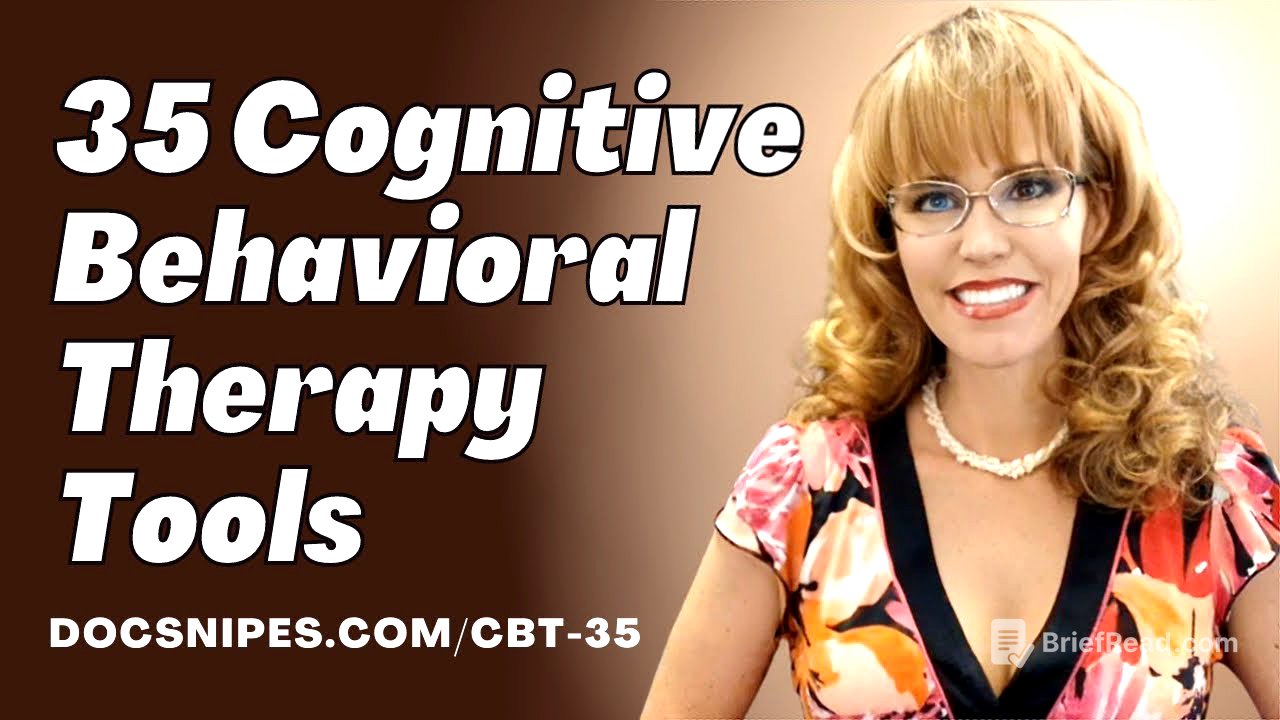TLDR;
This video provides an overview of 35 trauma-informed cognitive behavioral therapy (CBT) techniques designed to help individuals feel safer, more empowered, and move toward a rich and meaningful life. It emphasizes using people's strengths, recognizing their expertise in their own lives, and promoting self-care. The techniques range from creating safety and rescue packs to cognitive restructuring and mindfulness, all aimed at down-regulating the stress response and fostering a sense of control.
- Creating safety and empowerment
- Distress tolerance and emotion regulation
- Cognitive restructuring and mindfulness
Introduction to #traumainformed #cogntivebehavioraltherapy [0:00]
The video introduces 35 cognitive behavioral therapy (CBT) tools tailored for trauma survivors, designed to enhance feelings of safety and empowerment. It highlights the importance of leveraging individual strengths and acknowledging personal expertise in navigating life's challenges. The approach aims to help individuals recognize that coping mechanisms developed in response to stress, while potentially not always effective, served a purpose in their survival. It also focuses on identifying secondary effects of trauma, such as depression and anxiety, and promoting self-care strategies to facilitate progress toward a fulfilling life.
Creating safety [1:30]
Creating safety is fundamental, aiming to reduce hypervigilance and exaggerated startle responses by fostering a sense of security in various environments. This involves physical safety from self and others, addressing both external threats and internal struggles with overwhelming emotions or self-destructive behaviors. Emotional and cognitive safety focuses on managing the inner critic and setting boundaries to protect one's thoughts and feelings. Environmental safety involves creating a secure space where individuals don't fear for their cherished belongings or potential displacement.
Creating a rescue pack [5:00]
Creating a rescue pack involves assembling items to promote grounding, safety, and empowerment in unpredictable situations. This pack includes a thought list of distress-tolerant mantras, activities to trigger the relaxation response (like breathing exercises or blowing bubbles), a phone for reaching out to support, and the local crisis line number. Narration can help stay grounded, while essential oils or wax tarts can evoke relaxation or displace trauma triggers. An anchoring object provides a tactile sense of security, and jolting techniques like splashing cold water can interrupt distress spirals. Music playlists and noise-canceling headphones offer auditory comfort or relief from triggers.
Distress Tolerance [11:30]
Distress tolerance involves using thoughts, activities, guided imagery, and sensory tools to down-regulate the stress response. Thoughts include distress-tolerant mantras, while activities aim to reset the HPA axis and improve vagal tone through breathing exercises or vagus nerve massage. Guided imagery, such as mental vacations or envisioning safety, promotes relaxation and dopamine release. Sensory tools, like smells or sounds, help trigger the relaxation response, providing a break from distress and enabling a person to address it through their wise mind.
Breathwork [17:05]
Breathwork is crucial for triggering the vagus nerve and promoting relaxation. Slow, deep diaphragmatic breathing, or belly breathing, stimulates the vagus nerve, leading to respiratory vagus nerve stimulation (RVNS). Square breathing, involving inhaling, holding, exhaling, and holding for four counts each, slows the heart rate and overrides the stress response. Yawning, laughter, blowing bubbles or bubble gum, and using party noise makers are alternative methods to slow breathing. Fitness trackers can also be used to monitor and intentionally lower heart rate, indicating the activation of the relaxation response.
Defining your rich and meaningful life [22:50]
Defining a rich and meaningful life involves identifying personal values and goals to guide energy allocation. Creating a vision board helps visualize these aspirations, encompassing relationships, health, career, and personal interests. This vision serves as a daily reminder of what is important, aiding in decision-making by assessing whether an action aligns with or detracts from these core values. The vision board can be kept on a mobile device for easy access and refocusing throughout the day.
Purposeful Action [24:53]
Purposeful action involves mindfully acknowledging the present and strategically using energy to move toward a rich and meaningful life. This includes assessing whether to address a situation, change one's reaction, or recognize it as a distraction. It encourages evaluating whether holding onto emotions like anger helps or hinders progress toward personal goals. Purposeful action empowers individuals by highlighting their options and fostering a sense of control.
Symptom Logs [26:30]
Symptom logs are used to document incremental changes in mental health symptoms, identify triggers and vulnerabilities, and track coping effectiveness. Logs should include the date, time, trigger, intensity, duration, impact on various life aspects, vulnerabilities, coping strategies, and their effectiveness. For persistent symptoms, hourly logs can be completed. Reviewing logs helps identify themes, triggers, and vulnerabilities, often visualized through pictographs of frequency, intensity, and duration. A mathematical formula can quantify overall improvement by considering frequency, intensity, and duration. Alternative logs can assess generalized anxiety on an hourly basis, with the goal of gradually decreasing the average anxiety level over time.
Systematic desensitization [39:00]
Systematic desensitization helps alter reactions to triggers by creating a safe environment and empowering individuals to manage their stress response. This involves learning about the trigger, thinking about it, and using distress tolerance skills to dampen the stress response. Progressively, the person imagines being in a room with a caged snake, then with someone holding a snake, and eventually petting or holding a snake. The goal is to decouple the stress response from the trigger, enabling effective evaluation of the situation in the current context.
Immersion [45:30]
Immersion, or ownership, involves regular exposure to a trigger while managing one's response, diminishing its power. This technique is suitable for annoyance triggers rather than those causing a flood of stress chemicals. It can involve making a smell or saying one's own, pairing triggers with positive associations, and regularly exposing oneself to the trigger while regulating the stress response. Systematic desensitization should be undertaken with care to prevent moving forward too quickly and causing additional anxiety or re-traumatizing yourself.
Mindfulness [47:25]
Mindfulness involves turning off autopilot and being non-judgmentally aware of thoughts, feelings, needs, and behaviors in the present moment. It connects thoughts, feelings, and behaviors, promoting prevention and early intervention of distress. Personal mindfulness includes checking in with oneself throughout the day to assess physical and emotional states and identify needs. Grounding techniques, like the 54321 method or describing an object, help stay connected to the present. General mindful awareness encourages noticing the surroundings, while mindful reflection involves evaluating daily activities to determine their effectiveness in moving toward personal goals.
Grounding [49:35]
Grounding is a mindfulness technique that helps people feel connected to the present moment and not swept up by emotions or thoughts. Two common grounding activities are the 54321 method, where one identifies five things they see, four things they hear, three things they smell, two things they feel, and one thing they taste, and describing an object, where one focuses on the physical sensations of an object to stay anchored in the present.
Mindful Awareness [50:20]
General mindful awareness encourages people to be aware of the moment, not just themselves, but the moment in general. It involves becoming more mindful in actions, noticing what is seen, heard, and smelled. Mindful reflection is an activity in which people reflect on their activities at the end of the day, asking themselves if their actions were an effective use of their energy to move toward their rich and meaningful life or if they were acting as a happy, healthy, and successful person would.
Authenticity [53:55]
Authenticity involves being true to oneself, rather than seeking approval from others or operating on autopilot. It requires mindfulness of one's thoughts, feelings, and needs, and acting in accordance with them. Separating approval or disapproval of behaviors from oneself is crucial. Exploring and addressing fears related to being authentic is important, and practicing assertiveness and authenticity with safe individuals first is advisable. Radical authenticity may not be safe for everyone in every situation, so individuals must decide the extent to which they can be authentic in various environments.
Thought Stopping [59:10]
Thought stopping helps redirect the brain by telling oneself "no," replacing the thought with a mantra, prayer, or grounding activity. If the thought persists, one should evaluate the benefit of ruminating on it and address the underlying issue. Writing down persistent thoughts and scheduling worry time can be helpful. Starting small, by attempting to stop the thought for five minutes, can empower individuals to recognize their ability to control intrusive thoughts.
Perspective Taking [1:01:40]
Perspective taking involves looking at the bigger picture to understand the reactions of oneself and others. The four P's of perspective taking include predisposing factors (background factors contributing to behavior), precipitating factors (vulnerabilities and contextual factors), provocations (triggers), and plans (intentions and reactions). It encourages recognizing the influence of historical experiences and considering whether one's own behavior may have inadvertently provoked a reaction.
Self Forgiveness Letting Go of Guilt [1:05:00]
Self-forgiveness involves choosing to stop using energy to beat oneself up, without condoning the situation. The four R's of self-forgiveness include responsibility (taking responsibility for one's actions), remorse (feeling guilty but using that energy to learn), rectifying (making amends or learning from the situation), and releasing past hurt (accepting imperfection and choosing not to continue self-punishment).
Forgiving others [1:08:00]
Forgiving others involves choosing to stop giving energy to the person or memory causing distress. This includes recalling the betrayal, exploring fears about forgiving, and visualizing forgiveness as a gift to oneself. Learning from the experience and adjusting expectations is crucial. Living in the "and" means one can have a rich and meaningful life and not trust the person anymore. It can help to empathize without minimizing, safely share feelings, and practice thought stopping when resentment creeps back up.
ABCs of CBT [1:10:30]
The ABCs of CBT involve identifying the activating event (A), the consequences (C), and the beliefs (B) that mediate between them. Consequences include emotional, physical, cognitive, and relationship reactions. Beliefs, often based on past experiences, may not be accurate in the present context. Disputing (D) these beliefs involves evaluating their accuracy based on current facts. Evaluating (E) the effectiveness of one's reactions helps determine whether they align with moving toward a rich and meaningful life.
Handling Cognitive Distortions [1:12:50]
Cognitive distortions involve faulty patterns of thinking that can lead to distress. Common distortions include all-or-none thinking, personalization, magnification or catastrophizing, minimization, and assuming (mind reading and jumping to conclusions). Addressing these distortions involves reframing extreme language, considering alternative explanations, and checking assumptions against facts. A cognitive distortions worksheet can help individuals identify and evaluate their beliefs for distortions.
Problem Formoulation PEACE CORPS [1:17:00]
Alternate problem formulation, using the mnemonic PEACE CORPS, involves identifying the problem, early experiences, assumptions, core beliefs, effectiveness of assumptions and core beliefs, context, options, resources, probability of success, and support. This approach connects past experiences to present perceptions, helping individuals understand why they assume certain things to be true. It also encourages evaluating the effectiveness of assumptions and core beliefs in the current context and identifying options and resources to handle the situation.
Tragic optimism CRAB GRASS [1:19:15]
Tragic optimism, summarized by the mnemonic CRAB GRASS, involves embracing the good with the bad and finding meaning in difficult situations. It starts with creating a vision of a rich and meaningful life, radically accepting the current reality, and anticipating the positive. Being present and mindful helps address grief and adjust to changes. Growth and learning are fostered by using the experience to improve life. Realistic goals and expectations are set based on the new reality, and self-affirmation is practiced one step at a time. Solutions are found for problems, and serenity is achieved by accepting what can and cannot be changed.
Challenging Questions FACE PALM [1:24:15]
Challenging questions, represented by the mnemonic FACE PALM, involve evaluating beliefs when feeling distressed. This includes identifying facts for and against the belief, considering additional factors and the context of the situation, and avoiding extreme language. Probability or likelihood is assessed to determine the likelihood of a catastrophic outcome. Alternate explanations are explored, and learning from the experience is used to move forward.
Radical Acceptance FACE it [1:26:20]
Radical acceptance, represented by the mnemonic FACE it, involves accepting the moment as it is. This includes identifying facts for and against the belief, accepting the present and acknowledging what cannot be changed, and eliminating "shoulds." Control is then identified by determining which aspects of the situation can be controlled and how to best use energy to cope. Finally, the effectiveness of choices is evaluated.
Successive Approximation and Scaffolding [1:28:20]
Successive approximations involve striving to get a little bit better or closer to the goal every single time. Scaffolding involves letting someone do something up until the point they need help, prompting successive approximations. This approach helps individuals feel empowered and capable, and can be applied to various tasks, including anger management.
Hardiness Commitment Control Challenge [1:30:35]
Hardiness is represented by commitment, control, and challenge. Commitment involves identifying all the things in one's rich and meaningful life to which they are committed. Control involves identifying what aspects can be controlled in both positive and negative situations. Challenge involves seeing difficult situations as opportunities to strengthen existing skills.
Play the tape through [1:33:30]
Playing the tape through involves considering all factors and options, both in the short and long term, before acting or reacting. This means beta testing before making decisions based on emotions. It requires considering the long-term consequences of actions, such as quitting a job or engaging in triggering behaviors.
Decisional Balance [1:36:00]
Decisional balance involves looking at the benefits and drawbacks of both change and staying the same. This includes considering emotional, physical, interpersonal, financial, and legal aspects. By breaking down these quadrants, individuals can identify their motivations for change and address potential obstacles.
Cognitive Restructuring [1:38:11]
Cognitive restructuring, involving dialectics and radical acceptance, means embracing the positive and negative aspects of a situation. This involves recognizing that one cannot have one without the other, such as feeling vulnerable in a relationship or experiencing distress during therapy.
Autobiography [1:40:25]
Autobiography can be a helpful tool, involving writing one's life story from various perspectives, such as the adult self, someone else's perspective, or the child self. This can help individuals gain insight into their experiences and how they have changed over time.
Letter Writing [1:42:00]
Letter writing involves getting thoughts and words out of one's head and putting them out in the open. This can involve writing letters to one's future self, past self, or other people from the past, in the voice of one's past self, present self, or future self.
Journaling [1:43:35]
Journaling can involve daily reflection, symptom logs, mindful journaling, or journaling about particular feelings. It can also involve journaling from the perspective of the inner child, the manager, or the firefighter, archetypes from internal family systems theory. Journals can be written in text, video, or audio format, and can be verbal or graphic.
Guided imagery [1:46:00]
Guided imagery can be used for emotional or physical pain, helping individuals envision turning down the intensity of their pain or seeing it as a color that fades away. It can also involve envisioning the body healing itself or a wave washing away anxiety. Guided imagery can be used for anticipatory anxiety, growth, and sleep.
Health Literacy [1:49:30]
Health literacy involves education and understanding the connection between one's mind and body, thoughts and symptoms, and past experiences and present reactions. It is important to understand the impact of cognitive development on perceptions, especially for those who encountered trauma early on. Cognitive behavioral therapy empowers individuals to learn about tools, decide whether to use them, and arrive at their own conclusions when evaluating thoughts, beliefs, and perceptions.









